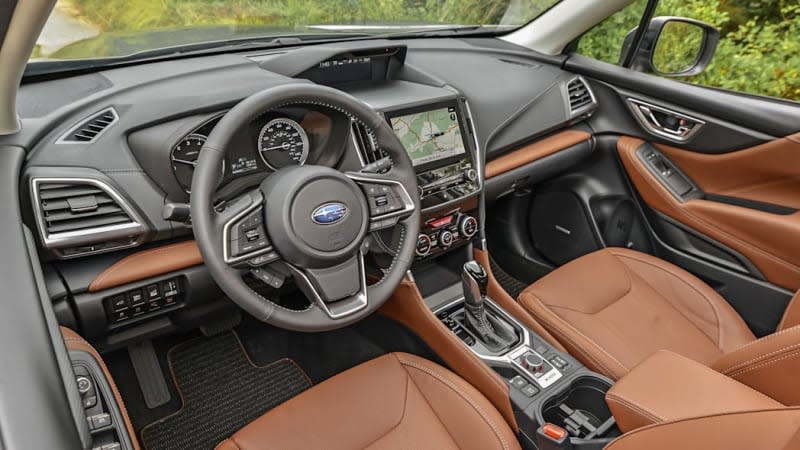2024 Subaru Forester Review: To wait or not to wait (for the new model)

Pros: Wilderness trim excels off-road; great visibility; tons of space inside
Cons: Dreary powertrain; sloppy handling; dated tech; upper trim levels less luxurious than rivals
OK, so let’s get this out of the way: If you buy a 2024 Subaru Forester, you’ll be foregoing a multitude of updates and upgrades coming for the 2025 model year. The good news is, it’s really not that different. Despite the updated looks, upgraded tech features and revised trim levels, the next Forester is mechanically similar to the one sold for 2024. In short, you’re not missing that much, and we don't know when the next-generation Wilderness may arrive. It may be another model year.
Now that that’s out of the way, let’s talk about how the Forester stands in the greater compact SUV segment. Its standard all-wheel drive, class-leading ground clearance, ample cargo capacity, sturdy roof rails and a relatively simple interior all help the Forester’s cause. The aforementioned Forester Wilderness delivers even more of the above for folks wanting greater capability than the standard model. Indeed, those would be the folks for whom the Forester will have its greatest appeal. There’s no surprise that it’s so popular in the Pacific Northwest, Colorado and Northeast.
In most other respects, though, and for less specific buyers, the 2024 Forester falls short. Its design and styling won’t turn any heads, and the powertrain, consisting of a naturally aspirated boxer four-cylinder and continuously variable transmission, is merely acceptable for the class. There’s also no hybrid available. The tech Subaru has on offer feels dated and slow, and while the infotainment system itself is easy to use, we can’t say the same for the busy cluster and funky screen above the infotainment (this is one area where the 2025 Forester improves upon, but as we’ve sampled its upgraded system in other Subarus, we know it’ll still fall well short of the segment’s best. Its ride is comfortable enough, but a noisy cabin and lackluster handling won’t impress anybody. For all these reasons, the Forester finds itself toward the middle and rear of the pack when compared to standouts like the Honda CR-V, Kia Sportage, Hyundai Tucson, Toyota RAV4, Nissan Rogue and Mazda CX-50.
Interior & Technology | Passenger & Cargo Space | Performance & Fuel Economy
What it's like to drive | Pricing & Trim Levels | Crash Ratings & Safety Features
What's new for 2024?
The Forester carries over unchanged for the 2024 model year, but if you think you saw something about a new Forester coming, you’re not wrong. The Forester will be heavily refreshed for next model year, and you can read all about it in our 2025 Subaru Forester Preview.



What are the Forester interior and in-car technology like?
The Forester's interior design is function-first, with a sensible control layout and visibility that rivals the Popemobile. The materials are of an acceptable quality, and driving for hours on rutted dirt roads proves it's all put together well. But don’t expect fake wood trim or fake leather applied to the dash and doors – the Forester isn't trying to be something it isn't. Instead, color is used to spruce things up, with orange in the Sport, copper in the Wilderness and camel in the ritzier Touring (all pictured above). For those whose wardrobe and gear could mostly be sourced from REI, a Forester should fit right in.
The in-car tech is similarly sensible and easy-to-use, although opting for the 8-inch touchscreen upgrade over the standard 6.5-inch unit is certainly helpful. The big icons are easily read and pressed, which is good when you're on a bumpy dirt road (or just on terrible pavement). We also appreciate that Subaru has maintained physical buttons and knobs for menu selection and controls that aren't well-suited to touchscreens. On the other hand, the combination of touchscreen, instrument panel display and the unique dash-top display can make it difficult to know where to see or control certain vehicle functions. Buttons on the steering wheel are also tasked with operating both the IP and dash-top display, which presents a steep learning curve for new buyers. Subaru has cleaned this all up in the Outback and Crosstrek by dropping the dash-top screen in favor of a much larger main screen, but that sadly won’t make it to the Forester until 2025. On the upside, the dash-top display is the perfect spot to show the forward camera feed in the Wilderness, which is a big help when negotiating tough terrain.


How big is the Forester?
The Forester has basically the same exterior dimensions as its main rivals, the Honda CR-V, Toyota RAV4, Hyundai Tucson and, to a lesser extent, Jeep Cherokee. Backseat space differs more between them, but they're all generously spacious and well within the realm of "family friendly." In fact, these are the most spacious compact SUVs. Still, the Forester stands out with its boxy side windows (visibility is exceptional even for back-seat occupants) and the ample recline of its seat back.
In terms of cargo space, the Forester's 28.9 cubic feet (or 26.9 with its jumbo sunroof) seemingly falls nearly 10 cubic feet short of the Kia Sportage, Hyundai Tucson, Toyota RAV4 and Honda CR-V. This is curious, however. Subaru originally published cargo capacity numbers of 35.4 cu. ft. and 33.0 cu. ft. (no sunroof) for this Forester generation. Those would be far more in keeping with what we saw when actually loading it up with luggage. Although still a bit short of the segment's big boys, it's actually closer to them than its current cargo capacity figures would indicate on paper.
It's also worth noting the Forester's class-leading ground clearance. At 8.7 inches, only the Jeep Cherokee Trailhawk, specifically, can match it, with the Toyota RAV4 TRD Off-Road and Adventure falling just a bit short at 8.6. Remember, this is the base Forester, not a special off-roading trim level like those of its rivals. The Forester's own special off-roading trim, the Wilderness, cranks things up to 9.2 inches and shaves off some bumper to further improve its approach angle. Though it still can't match the Trailhawk's approach and departure angles, it's better than everything else, including other Cherokees. The same can be said for the Forester's roof rails, which are capable of supporting more weight than everything in the segment – with the Wilderness again upping the ante even further.


What are the Forester fuel economy and performance specs?
The Forester can only be had with a 2.5-liter boxer four-cylinder engine good for 182 horsepower and 176 pound-feet of torque, which is low for the segment. It is exclusively paired to all-wheel drive and a continuously variable transmission (CVT), which tries to simulate the gear shifts of a normal automatic. Its set ratios are altered in the Wilderness for sharper response and performance better suited to driving off-road.
Fuel economy is 26 miles per gallon city, 33 mpg highway and 29 mpg combined in all Foresters but the Wilderness. Its different transmission ratios, all-terrain tires and altered aerodynamics result in lower figures of 25 mpg city, 28 mpg highway and 26 mpg combined.


 Yahoo Autos
Yahoo Autos 
